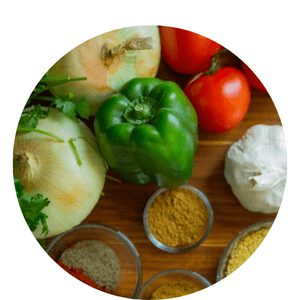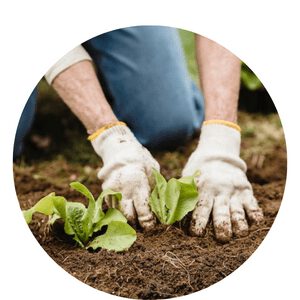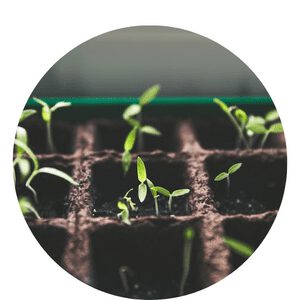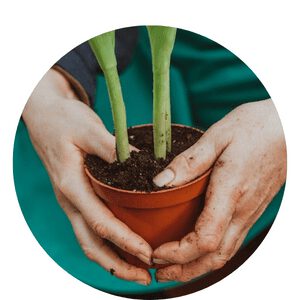Harvesting and Storage
Organic gardening is an increasingly popular method of growing food, as it proves to be a healthier and more sustainable option than traditional chemical-based methods.
Along with the positive environmental aspects, organic gardening requires that gardeners be familiar with the harvesting and storage process.
To reap the greatest benefits of an organic garden, gardeners must learn how to properly harvest and store their produce in order to maximize taste, freshness and nutrition.
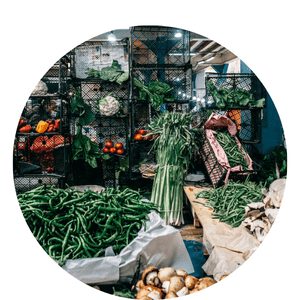
Harvesting and Storage Menu
Harvesting and storage in organic gardening
Organic gardening is a vital part of sustainability and food security.
Knowing how to properly harvest and store your organic produce is key to preventing food waste, preserving nutritional value, and extending the shelf life of your plants.
Here’s an overview on what harvesting and storage entail in the realm of organic gardening.
Harvesting is the process of gathering ripe fruits or vegetables from their plants for eating or preservation.
It involves cutting, picking, or otherwise collecting the matured produce from its source.
Organic gardens typically require careful attention to detail when it comes to harvesting; timing is essential as some fruits or vegetables may spoil quickly if left too long on the plant before being collected.
Storage follows harvesting, allowing gardeners to keep their produce for future use by removing moisture from them through various techniques like canning, freezing, drying and pickling.
Importance of harvesting and storage in maintaining the quality and freshness of produce
Organic gardening is an environmentally conscious practice, focused on growing produce without synthetic fertilizers or pesticides.
It requires a great deal of knowledge and skill to be successful in organic gardening, which includes the proper harvesting and storage techniques to ensure the highest quality and freshness of the produce.
Harvesting fruits and vegetables at the right time is essential for maintaining their nutritional content, flavor, aroma, and texture.
For instance, tomatoes must be picked when they are fully ripe in order to retain their flavor.
Similarly, some leafy greens should be harvested before they reach maturity if you want them to remain tender and sweet.
Knowing when certain produce should be harvested can help you maximize its quality and freshness before it goes into storage.
Proper storage also plays an important role in preserving the quality of your produce for as long as possible.
Harvesting Techniques
Harvesting and storage are two essential components of any successful organic gardening strategy.
The type of harvesting techniques used to collect produce can have a major impact on the quality and longevity of fruits, vegetables, herbs and other crops grown in an organic garden.
When it comes to harvesting techniques, timing is everything.
Picking fruits and vegetables at the peak of ripeness ensures they will be as nutritious as possible and retain their flavor for a longer period of time.
Different types of produce require different methods; for example, tomatoes should be gently plucked from the vine while carrots should be pulled from the ground with gentle pressure applied to avoid breaking them off.
Herbs can usually be harvested by cutting off sprigs or leaves with scissors or pruners when needed.
Tips for selecting ripe produce
When selecting ripe produce for harvest, there are a few key tips to keep in mind.
Start by looking for produce with bright, vibrant colors and an even shape.
Fruits should be firm but still slightly soft when touched gently, and vegetables should have a fresh smell.
Also make sure to check the stems or stalks of the fruits or vegetables to ensure they are not wilted or broken off completely.
For fruits such as apples and oranges, look at their skin color and texture before harvesting them.
Apples should be free of bruises and have deep red hues if they’re meant to be eaten raw.
Oranges should also appear bright orange on the outside with no signs of discoloration.
Additionally, pay attention to the ripeness of certain types of greens like lettuce – it will become bitter the longer it stays in the ground!
t elit tellus, luctus nec ullamcorper mattis, pulvinar dapibus leo.
In the garden, come harvest time The fruits and veggies fill our minds To reap what once we have sewn We care for organic soil with our own Baskets full of goodies, glistening in the sun We package them for future visits, having so much fun When winter comes around and heat we'll miss Organic harvest stored, we can enjoy its bliss
Chappy The Gardener
Techniques for harvesting different types of produce
Harvesting and storage of produce is one of the most important parts of organic gardening.
To ensure that your garden yields the highest quality produce it is essential to use the right harvesting techniques for each type of crop.
Different types of fruits and vegetables require different harvesting methods, such as cutting, picking or pulling.
Cutting is best used when harvesting lettuces and other leafy greens like spinach or kale.
Careful attention must be taken when using a knife to avoid bruising these delicate plants, which can lead to premature spoilage.
Picking is often necessary with grapes, raspberries and strawberries as well as some herbs like oregano or basil; ensuring that you pick only ripe fruits will help deliver maximum flavor in your finished dishes.
Tools and equipment needed for harvesting
Harvesting is one of the most exciting steps in organic gardening, as you get to reap the rewards of your hard work.
The harvesting process requires specific tools and equipment in order for it to be effective and efficient.
From knives and pruners to sickles and harvest baskets, these essentials will help make sure that you are able to collect every last vegetable or fruit from your garden.
Knives are usually the first tool used for harvesting fruits and vegetables from a garden.
They can be used for slicing off produce from vines or stems, while also coming in handy when trimming off leaves or removing dead parts of the plant.
Pruners are also great tools for harvesting, as they provide an easier way of cutting through tough branches or stems without leaving any damage behind.
Sickles have a curved blade which allows them to cut through plants quickly with minimal effort.
Storage Techniques
Organic gardening is a sustainable and natural way of tending to plants.
Harvesting and storage are two important elements in organic gardening that are often overlooked by novice gardeners.
The key to successful storage is choosing the correct technique for each crop you harvest.
For instance, root vegetables such as carrots and potatoes should be kept in cool and dark environments with high humidity levels.
Fruits such as apples and pears can be stored in cool temperatures with moderate humidity levels for longer shelf life.
For leafy greens, it’s best to keep them refrigerated as soon as possible after harvesting in order stop any discoloration or wilting from occurring.
Choosing the right storage containers and methods
Organic gardening involves careful harvesting and storage of produce, to ensure that the highest quality of fruit and vegetables are produced.
To get the most out of your organic garden, choosing the right storage containers and methods is essential.
When selecting a container for storing your produce, pick one that is non-porous, with a lid that seals shut tightly.
This will help to keep moisture and air out, as well as prevent bacteria from growing inside.
It’s also important to make sure you choose an appropriate size for your needs – too large or too small can both be detrimental to preserving freshness.
It’s also recommended to have multiple containers on hand so you can transfer vegetables at different stages in their ripening process into separate containers.
Tips for storing different types of produce
Harvesting and Storage is an important part of organic gardening.
To ensure the best produce, it’s important to have the right storage methods in place.
Here are some tips for storing different types of produce:
Refrigeration is a great option when it comes to keeping fruits and vegetables fresh.
Fruits and vegetables that should be refrigerated include apples, carrots, tomatoes, cucumbers, lettuce and herbs.
Be sure to keep these items away from moisture as humidity can cause them to spoil quickly.
Freezing can also be an effective way to store certain types of produce such as berries, greens and even some root vegetables like potatoes.
When freezing items like berries or greens make sure that you blanch them before hand – this will help preserve their color and flavor for longer periods of time in the freezer.
Techniques for preserving produce
Preserving produce is an important part of organic gardening.
By harvesting and storing fruits and vegetables properly, you can extend their shelf life significantly.
There are several techniques available for preserving produce, including canning, pickling, and freezing.
Canning is a popular method for preserving produce that utilizes heat and airtight containers to create a vacuum seal.
This prevents the growth of harmful microorganisms that cause food spoilage and keeps the food safe for consumption.
Pickling involves submerging fruits or vegetables in an acidic solution such as vinegar or brine to create an environment where bacteria cannot thrive.
This also gives foods a unique flavor, making it perfect for homemade condiments like sauerkraut or relishes. Lastly, freezing is a simple way to preserve produce with minimal effort.
Common Challenges and Solutions
Organic gardening is a rewarding process that produces fresh and delicious fruits, vegetables, and herbs.
However, there are common challenges that can arise when harvesting and storing organic produce.
In this fourth installment of the Harvesting and Storage in Organic Gardening series, we will discuss the most frequent issues found in the harvesting and storage process and their solutions.
When it comes to harvesting, one issue is knowing when to pick your produce; underripe fruits or vegetables cannot be stored for long periods of time while overripe items may rot quickly.
To avoid these problems, research the individual plant’s optimal harvest times as well as any signs of ripeness or maturity like size or color changes.
It is also important to have proper tools on hand such as pruning shears or scissors for delicate items like berries or herbs that require precision cutting.
Dealing with pests and diseases during harvesting and storage
Harvesting and storage of organic produce can be a difficult process, as pests and diseases must be prevented in order to keep the quality of the goods high.
Proper harvesting techniques are essential to maintaining healthy crops, as pests and diseases spread quickly if the produce is not handled correctly.
It is thus important to understand how to prevent common issues during harvesting and storage.
One way to deal with pests or diseases during harvesting is by selecting only healthy fruits and vegetables for sale.
If any signs of disease or pest infestation are noticed, they should be removed immediately before they have a chance to spread.
Additionally, proper sanitation procedures should be monitored at all times during harvesting in order to reduce contamination from outside sources.
Finally, it is important to store the harvested goods properly in airtight containers so that insects cannot enter them during storage.
Maintaining the quality and freshness of produce during storage
Consumers of organic produce expect it to be of the highest quality and freshness.
For growers, harvesting and storage techniques can have a major impact on preserving this quality and preventing spoilage.
Inorganic growing methods often involve pesticides and preservatives that may help maintain the shelf-life of produce, but organic methods focus on natural strategies to keep fruits and vegetables at their best.
Organic gardeners need to understand harvesting times for different varieties of produce in order to maximize their yield while ensuring an optimal level of freshness and taste.
Proper collection techniques are also necessary, as rough handling can damage delicate fruits or vegetables.
Once harvested, temperature regulation is essential for longer-term storage; if kept too cold, the result can be chilling injury or frost damage.
How to know when produce is ripe for harvesting
Harvesting and Storage in organic gardening is a key part of maintaining an enjoyable and successful growing experience.
There are several ways to tell if the vegetables, fruits, and herbs you have been tending to are ready for harvest.
The first indicator that produce has reached its peak ripeness is color.
Fruits such as apples, blueberries, oranges, and pears should be richly colored before they are harvested.
Vegetables like tomatoes, peppers, eggplants, beans, and squash will also turn colors when ripe; green peppers become bright red or yellow for example.
Additionally there may be specific size requirements for each vegetable so it’s important to research what looks best when harvesting specific produce from your garden.
How to store produce for long-term storage
Harvesting and storing produce is an essential part of organic gardening.
For long-term storage, there are two main methods you can use: freezing and root cellaring.
Freezing produce is a great way to store fruits, vegetables, and herbs in their peak state for months at a time.
To properly freeze produce, harvest when it’s ripe or nearly ripe and then blanch the food before freezing.
Blanching stops enzymatic development that can damage flavor, texture, color and nutrient content over time.
Once blanched, cool down food quickly by plunging it into ice water before storing in airtight containers or bags with as little air as possible so that oxidation isn’t a problem.
How to preserve produce for use during the off-season
Harvesting and Storage in Organic Gardening is an integral part of the organic gardening process.
It is important for gardeners to understand how to properly harvest and store their crops so that they can enjoy their produce throughout the off-season.
By following a few simple steps, organic growers can ensure that their produce remains intact during the off-season.
Firstly, it is essential for gardeners to harvest fruits at the peak of ripeness when nutrients are most available; this will also prevent spoilage due to overripeness or underripeness.
Secondly, careful storage techniques should be employed such as blanching and freezing which will extend shelf life by decreasing oxidation and microbial growth.
In conclusion, harvesting and storage in organic gardening plays an important role in producing the highest quality of produce.
Careful harvesting and proper storage can extend the shelf life of garden produce, reduce spoilage, and ensure that the consumer gets nutrient-rich foods.
It is essential to understand what crops require for harvesting and storage as each have their own specific requirements.
Home gardeners should be aware that proper harvesting and storage techniques are not only important to maintain the freshness of their produce but also increase the nutritional value.
Click To Grow
Helps Us Grow – Share If You Like












